Winter sowing in milk jugs is an easy way to start your cold hardy plants for next year's gardening season. If you like to start your seeds indoors while the snow is still on the ground, consider the winter sowing method, especially for your hardy annual and perennial seeds. This method of sowing is quick and easy, and has many benefits, including freeing up space on the seedling shelves for your more cold sensitive seeds.

The Basics Of Winter Sowing
What Is Winter Sowing?
Winter sowing is the process of sowing seeds outside in winter. The process involves planting the seeds into a container that will provide protection from the elements, while still allowing the seeds to naturally stratify in the cold winter environment. The container becomes a little miniature greenhouse with a protected microclimate, that is perfect for germination when the timing is right.
This winter sown container provides extra warmth, and protection from the wind and elements while the tiny seeds await germination.
In our own zone 5b garden, winter sowing allows us to plant some of our hardy annual and perennial seeds, and place them outside in winter. This is a great method for starting seeds in a cold climate, because once planted, all you have to do is wait until spring.

The winter sowing process frees up valuable space inside our home, for other more tender seeds, which are not tolerant of the cold.
Winter sowing is beneficial for perennial seeds, as well as for hardy annual seeds.
These seeds often have thick outer coats which require stratification to help break down the hard outer surface of the seeds. Stratification is important for many seeds, and assists with the germination process.
By placing the seeds outside in these mini greenhouses, they are exposed to freezing temperatures and thaw cycles, which help these thick seed coats to split and crack.
The resulting seedlings that are grown through this process, naturally acclimatize to the outside weather in the milk jug, and become hardy and strong.
These seedlings will become naturally hardened off, because they are already outside.

When To Start Winter Sowing
You can start planting seeds using the winter sowing technique at any time during the cold winter months. Starting in the months of January and February is ideal.
Make sure that you start the sowing process when the outdoor temperatures are very cold, and when there is no longer a risk for a warm spell that can stimulate germination. Early germination will likely result in seedling loss, once the temperatures freeze again.
A good rule of thumb is to wait until after the winter solstice. That way there is less risk for warm days to cause premature germination of the seeds.
If the seeds are sown during the freezing cold winter months, they will automatically germinate when the weather warms up in spring. They will come to life at exactly the right time for your growing zone.
In this case, the seeds will be just fine, protected in their little greenhouses, until the weather starts to warm up in spring, and they begin to germinate.
I usually start winter sowing in January, and continue to plant every week until late March, as milk jugs become available. It's a gradual process, and there's no rush at all.
Once the seeds are safely tucked away into their milk jugs, and positioned outside, all you have to do is wait until spring.

Preparing Your Milk Jugs
Milk jugs make perfect miniature greenhouses for your winter sown seeds. Let's have a look at how to prepare and plant into the jugs, and secure and place them outside.
Equipment Needed:
- recycled milk jugs
- pair of sharp scissors
- sharp knife or screwdriver
- plant labels
- duct tape
- permanent marker

Preparing The Jug
- Wash and rinse an empty plastic milk jug for your project. Make sure to rinse out all the milk, as well as all the soap from the rinsing.
- Then prepare to cut the container.
- The container will be cut in half, leaving a small hinge which helps to maintain the structure of the unit, and is helpful to have in place when putting the halves back together.

- I like to start the cut just below the milk jug handle, and off to one side. The small area of plastic directly below the handle is an ideal location for a hinge, and should remain intact.
- Starting on one side of the handle, make a horizontal cut, and continue to cut all around the jug until you get to the other side of the jug, just below the handle.
- Leave a little hinge of plastic on the jug, which allows for opening and closing, and also keeps the unit together.

- Next, make sure to puncture the bottom of the jug with a sharp knife or screwdriver to allow for drainage. I usually make about five or six small drainage holes.
- Good drainage is essential, because the jugs are open to the elements. They will be exposed to lots of snow and rain, and this moisture should be able to freely drain out of the bottom of the container.
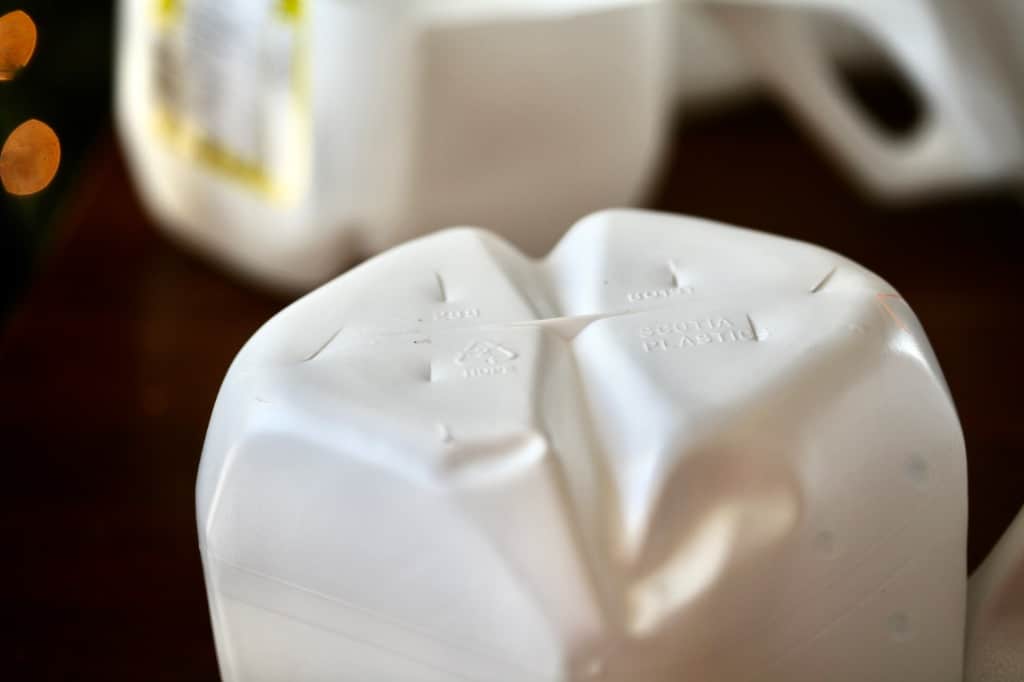
Filling The Container
- The next step is to fill the bottom half of the milk jug with a good quality potting mix. I prefer to use a sterile seed starting medium for all my seeds.

- Place about three to four inches of the mix into the bottom of your container, depending upon the volume of the container you are using. Essentially, fill up the bottom half of the container.
- Moisten the medium well with water before planting your seeds.

Planting The Seeds
- Next it's time to plant your seeds.
- Choose seeds that you know will tolerate the winter sowing technique.

- For any seeds that you are planting, it's important to follow the sowing instructions on the packet for depth and light requirements.
- Some seeds require light to germinate. Others like it dark.
- Some seeds can be sprinkled on the surface of the soil. Others need to be covered.
- I often cover with vermiculite, not only to provide darkness to those seeds requiring it, but also to help keep the moisture in the soil.

Label The Seeds
- Next it's time to prepare a plant label for inside the container, using a permanent marker.
- Since these containers are outside in the environment, there is a chance that a single label will be washed off by rain and watering. Every summer, there are always some labels which completely wash off.

- As a result, I make sure that there is always a second, or even a third means of identification for all winter sown seeds. I place a regular label inside the jug, along the edge of the soil, identifying the plant.
- Then I also label the inside of the jug, writing directly on the plastic surface, and then repeat again on the outside of the jug. Triple labeling has been very helpful.

Securing The Jug Shut
- After labeling, it's time to secure the container shut by taping it up to form the mini greenhouse.
- Push the top half of the milk jug back into place, and tape up the cut edges, making it whole again.
- I like to use duct tape for this project, as it sticks well, and generally stays quite secure for the period of time that the container remains outside.
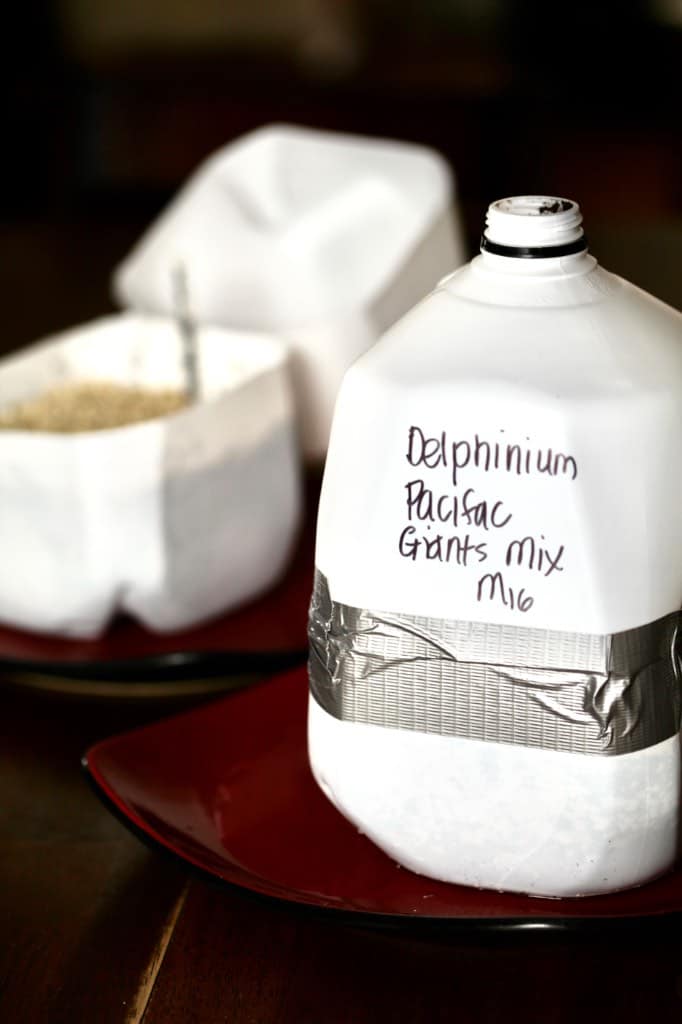
Ventilating The Jug
- These winter sown containers will require ventilation, right from the start.
- The easiest way to provide ventilation is to keep the plastic lids or caps off the jugs when you place them outside.
- This allows both the moisture to get in, and the heat to escape, during the winter sowing process. The heat inside the mini greenhouses can get quite warm when it starts to warm up in spring.
- Another option for ventilation is to poke small holes in the top of the jug, to allow for heat to escape.

Position The Jugs Outside
- The location and placement of your winter sown containers is also a consideration.
- Place in a sunny spot where they will be exposed to sunlight, but also have some protection from winds.
- High winds can knock over the containers, and disrupt the soil and the seeds inside.
- It can be helpful to wedge a row of milk jugs between heavy objects or structures. This provides some support, and helps the milk jugs to remain in an upright position.
- I wedge our milk jugs between two heavy chairs to prevent them from being blown over in the winter winds or storms. This has worked very well to keep them upright in a strong wind.

Managing The Milk Jug Greenhouses
1. Keep The Containers Secure
- Continue to keep an eye on your milk jugs to make sure that they stay upright, and are secure, to prevent tipping in the wind.
2. Monitor For Moisture
- Monitor your winter sown containers regularly in spring when it starts to get warm outside, to make sure that the soil stays moist. This is generally not an issue during the winter months.
- The jugs generally remain moist throughout the winter, and they do not require much watering until later in spring when the weather warms up.
- Make sure not allow the soil to dry out, especially when the seeds are germinating, because this will interfere with the germination process, and may interfere with plant survival.
- In early spring when the outdoor temperatures start to get warm, and at just the right time for your growing zone, the tiny seedlings will begin to germinate and sprout in their milk jug greenhouses.
- Make sure the seedlings are getting enough water. Use a spray bottle to mist the soil in the greenhouses as needed.

3. Watch For Overcrowding
- Keep an eye on the seedlings when they start to sprout.
- Make sure they have enough room to grow in their tiny greenhouse space.
- You can thin as necessary, or repot as necessary.
4. Maintain The Temperature
- If it starts to get too warm inside the containers, especially on sunny days, you can remove the tape and open up the jugs to allow for better air circulation.
- Do this gradually, slowly exposing the seedlings to the environment outside their mini greenhouse.
- This will also help the seedlings to further adapt to growing in the outside environment, helping them to harden off more fully.

5. Harden Off The Seedlings
- Winter sown seedlings are very hardy and sturdy seedlings to begin with, since they have been growing outside in the elements.
- However, they have been protected to some degree, and will benefit from further exposure to the outdoor elements by removing their protective cover. This will help to harden off the seedlings even further.
- You can do this slowly, lifting the cover for short periods of time.
- Eventually when the risk of frost has passed, you can remove the top of the container. Know the last frost date for your growing zone to be on the safe side.
- Transplant the seedlings into the garden, and enjoy the process of this fabulous winter sowing technique.

Best Seed Types For Winter Sowing
The types of seeds that have great success with the winter sowing method include those that withstand cold weather and freezing temperatures. These include both hardy annual, biennial and perennial seeds.

Some people also sow tender annuals, however in our zone 5b growing zone, tender annuals are at risk with this winter sowing technique.
Tender annual seedlings are easily killed by subzero temperatures and frost, and will require extra protection if winter sown in colder climates.
We only sow seeds that can tolerate the cold, and are able to be frozen and thawed.
Consider any flowers, herbs, or vegetables which you have noticed to self seed in your growing zone. These specimens are ideal candidates for winter sowing in your area.

Look also for any seeds which are directed on seed packets to be sown directly outside in the fall or early spring. These are also cold hardy cultivars which can be winter sown.
Many seeds which require stratification may be good candidates for winter sowing, although not all will fit the bill for freezing temperatures. For example, daylily seeds require a cold moist exposure for successful germination, however are not good candidates for winter sowing, as they tend to rot if they are frozen.
List Of Hardy Annuals For Winter Sowing
We sow many of our hardy annual flower seeds with the winter sowing technique. Here is a list of some common hardy annuals which are easily winter sown in cold environments:
- Apple Of Peru
- Bupleurum
- Bells Of Ireland
- Larkspur
- Bachelor Buttons
- Agrostemma (corn cockle)
- White and Green Mist Ammi
- Dara (chocolate lace flower)
- Sweet Peas
- Nigella (love-in-a-mist)
- Snapdragon
- Orlaya
- Poppy
- Scabiosa
- Chinese Forget-Me-Not
- Pansies
- Violas
- Cosmos


List Of Perennials For Winter Sowing
Perennial flowers are also easy to winter sow and grow using this easy sowing technique. Here is a list of perennials that are easy to winter sow:
- Milkweed
- Silene Blushing Lanterns
- Ice Plant
- Lupine
- Oriental Poppy
- Campanula (bellflower)
- Bergamot ( both perennial and annual cultivars)
- Columbine
- Black Eyed Susan
- Purple Cone Flower (echinacea)
- Goat's Beard
- Liatris
- Yarrow
- Sea Holly
- Iris




It's fun to experiment and to see what works for you in your growing location.
List Of Herbs And Vegetables For Winter Sowing
Many people also winter sow cold tolerant or cold hardy herb and vegetable seeds, depending on the growing zone as well as the hardiness of the herb or vegetable grown. Here is a list of just a few herbs and vegetables that are easy to winter sow:
- Calendula
- Chives
- Mint
- Chamomile
- Kale
- Spinach
- Arugula
- Brussels Sprouts
- Leeks
- Radish
- Swiss Chard
- Phacelia (Bee's Friend)
- St. John's Wort
- Borage

Transplanting The Seedlings
Depending on the seed type, and the growth within the container, sometimes it is easy to just to pull the soil apart in segments, and transplant the seedlings into the herb, vegetable, or flower garden in this manner.
I have had best success with this method if the seedlings are densely packed and would be damaged by root disruption from pulling out individual seedlings.
At other times, it is easy to separate individual plants, and to transplant individually.

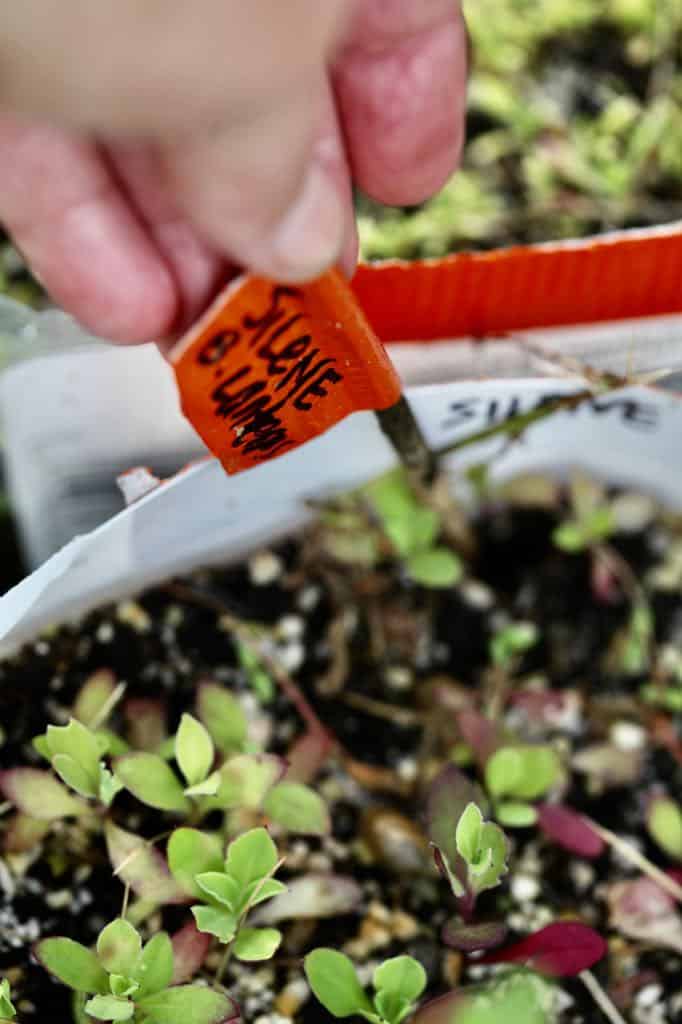
Benefits Of Winter Sowing
1. Assists With Stratification
- Winter sowing helps to stratify seeds by providing cold stratification.
- Stratification is especially important for hardy annual and perennial seeds. These seeds have adapted to be able to remain outside in winter, with their thick protective coats, and do not germinate until it warms up in spring.
- Those thick coats act as an insulation, and protect the seeds throughout the cold winter months.
- Cold stratification is required by many hardy annual and perennial seeds. Through this process, the seed coat breaks down, allowing for germination to occur.

- Cold moist stratification involves exposure to both cold temperatures, as well as moisture at the same time. This combination is very effective at helping to breakdown the seed coats.
- Winter sowing provides cold moist stratification. It provides both the cold temperatures, and the moisture in the form of ice and snow.
- This easy sowing technique helps to breakdown those tough seed coats, so that even the most difficult to germinate seeds seem to perform better.

2. Saves Space
- We sow a lot of seeds inside during the winter, and run out of space early. I was so glad to discover winter sowing several years ago, and have never looked back.
- Winter sowing frees up extra space on our indoor seedling shelves, and this makes a big difference when you plant a lot of seeds.

3. Helps Seedlings To Harden Off
- The winter sowing process also helps the seedlings to adapt to outside growing conditions, since they are growing outside in the elements.
- Winter sown seedlings are less at risk to stress from the outside environment, because essentially they are naturally hardened off from this growing method.
- They do require some extra steps to get them to the stage of being completely hardened off, however this process is quick for these already hardy seedlings.

4. Helps With Recycling
- Winter sowing is also a great way to recycle and reuse your plastic containers. I absolutely love rinsing out milk jugs when they are empty, because they are automatically recycled specifically for water sowing.
- Whenever we have a milk jug to recycle, we clean it up and plant it. It all adds up over time to lots and lots of spring time plants!

5. Saves Time And Effort
- Growing seedlings indoors can take a lot of effort to tend to their needs and to keep them healthy until they can be planted outside.
- Regular watering and care can be a full time job, depending on the number of plants that you are growing.
- Winter sowing seeds that can tolerate this method, can help to eliminate all the extra indoor care. It makes a big difference when you allow nature to take care of the needs of the plants.

6. Saves On Energy Bills
- Growing seeds inside can cost extra money, as there are expenses from using a heat mat and grow light indoors for several months.
- These are important pieces of equipment for successful indoor seedling care, however the costs can certainly add up over time.
- Any plants which can be winter sown will save you money on these expenses, as nature will be providing all those necessities for the seedlings that are winter sown.
- Native plants from your own growing zone are ideal candidates for winter sowing. These are tried and true plants for your own growing location.

Other Types Of Containers For Sowing
Many people use recycled milk jugs, juice containers, or water jugs for their winter sowing projects.
These containers are ideal, as they have a large base and are not easily tipped over by a strong winter wind. They also have a ready built ventilation hole, which is an important criteria for winter sowing.
They are also free.
Consider other types of recycled containers as well, such as those which provide a good sized surface for sowing, as well as have a cover to provide a greenhouse effect. Ideally the cover will be domed, to make space for the growing seedlings.
Large soda bottles will also work, however they have a smaller planting surface, and tend to be more at risk for blowing over outside, so make sure to secure them well.
Plastic bins with a clear plastic dome covering will also work well. These containers will need to be adapted to make a proper growing environment, with drainage holes and ventilation.
Use these plastic bins to plant into directly, or alternatively to hold smaller winter sown containers or pots snugly inside.


Key Criteria For The Containers
You can effectively use any type of recycled container for winter sowing, as long as they meet the following criteria:
- The container should be translucent enough to let some light in, which is important for warmth, as well as seedling germination and growth.
- Ideally the container will have an opening in the top, to allow moisture to enter the container. The opening should not be too large however, so that the seeds are greatly exposed to the elements. The size of a milk jug pouring spout is the perfect sized opening.
- This same opening also allows for some heat to escape, because it's important that the environment inside the container does not get too hot for the tiny seedlings.
- Containers should be light enough to easily be cut in half, so that you can fill the bottom half with soil, and use the top as a dome. Some containers are just too thick for an easy construction of these mini greenhouses.
- The container should also be light enough to be able to puncture some holes in the bottom, to allow for good drainage of any moisture that enters from the outdoor elements.
- Winter sown containers should always have some kind of covering, to allow for heat stay inside the container (like the top of the milk jug).
- The container should be able to maintain some heat, and accept some moisture. It's a pretty easy set up.

Conclusion
Winter sowing in milk jugs or other recycled containers provides a greenhouse-like environment, and is a great low-maintenance way to start hardy flower and vegetable seeds. It's also a great way to recycle your old milk jugs.
The winter sowing method gives cold tolerant seeds a head start on the growing season, and as a general rule helps them to grow strong and sturdy in the outdoor environment.
Every year I winter sow many different seed types, due to the ease of this process. Last year I grew more than ever before.
Winter sowing in milk jugs is almost a hands off method of growing, letting mother nature take care of the watering and direct sunlight needs of the tiny germinating seedlings.
It's a simple process that gets hardy seeds off to a great start.
You may be surprised at just how easy it is to winter sow seeds. It offers many advantages, and I hope that you can give it a try!

Have you ever tried winter sowing in milk jugs? Be sure to leave a comment below to share your experience!
Other Posts You May Like:
PIN IT FOR LATER!
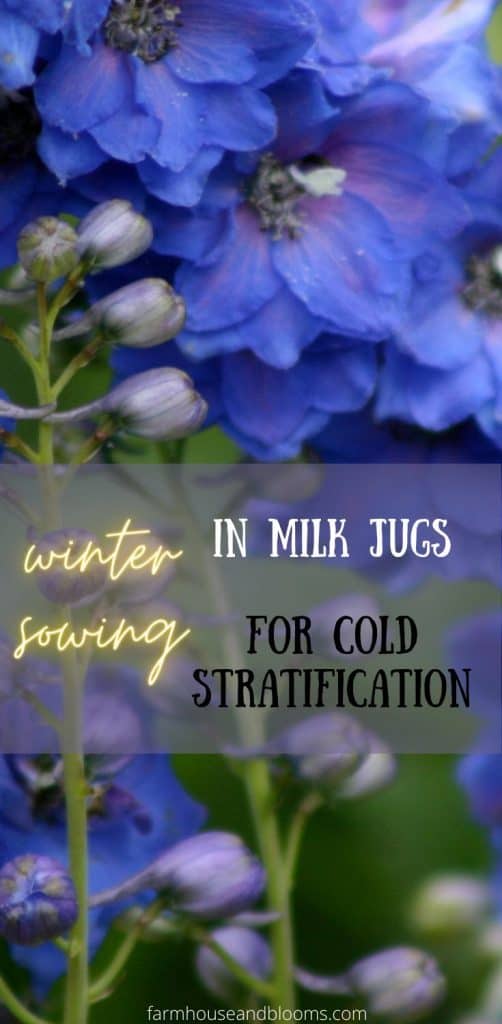



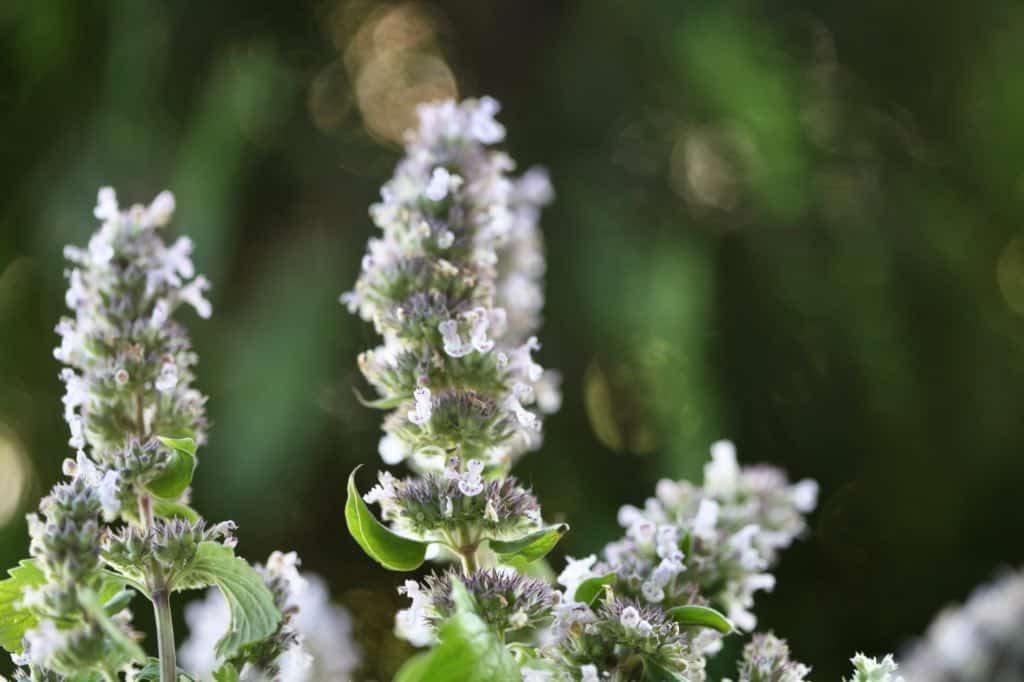





Julie
Very insightful article! I've had success winter sowing shasta daisies and lupins but haven't tried any veggies or hardy annuals. Adding vermiculite is a great tip that I will have to try next year!
cheyanne
We use vermiculite often when planting seeds, with great success!
William MacFarlane
Cheyanne, First time winter sowing nicotiana. The seed are like dust. It requires stratification..
I put them in a mini ice cube tray and froze them overnight to make it easier to distribute the seeds in the container. They also require light to germinate. Once the ice melts they will be on the surface.
It is February 1 in zone 5B. Do you think this is a good idea?
Cheyanne Mullin
Hi William, that sounds like a good way to distribute those tiny seeds. Time will tell how they tolerate this method. I sometimes just sprinkle the seeds on the surface by holding them between my thumb and forefinger, and go more by feel than visualizing the seeds if they are that small. Winter sowing is such a fabulous method of seed sowing. Best of luck with your flowers!